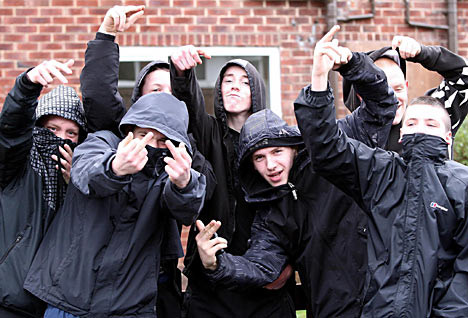Above is the preliminary task that I worked on at the start of the year. I feel that my skills have definitely improved since the making of this task, as I have learnt more about technology and camerwork, and have had more time to develop my skills. I feel more confident in my camerwork and framing of shots than I did when making this product, and I think that I have developed my editing skills alot more. Even though I am proud of my preliminary task, I feel that I can make much better products now that I have learnt more.
My main task is better than my preliminary task because my main task shows a lot more skills than this preliminary task does, and my main task makes use of lighting, sound, and narrative more than this product does. No establishing shot is included in this preliminary task, and I feel that my camerawork is better on the main task, as things such like extreme close ups are used in my main task, whereas I don't make use of close-ups here. I feel that my main task looks more professional than this does, and I did spend more time on the main task and had learnt a lot leading up to the making of it.
In terms of working in a group I have also learnt a lot. I have learnt that with working with a group of people you're not really that close to or don't share that many same ideas with can be tricky, but you have to make compromises with eac hother on ideas and how to, for example, film a particular shot, in order to get a good result. I've also learnt that you have to put trust in the people you're working with, for example we shared some responsibilites on the research and planning stage, and you have to have faith that the people you're working with will complete the tasks on time and to a good standard, which can be risky. Even though I often prefer working on my own so that I can be responsible for the work and the standard that I produce, there are benefits to working within a group, as you get ideas that you would never have thought yourself, and a group dynamic can often get work done quicker and to a better standard than if it was completed just by myself.
I have learnt about myself that I can work in a group, even with people that I wouldn't set myself up working with. I have also learnt a lot about film making techniques, and learning about new software and hardware like Scribd and audio recording equipment has been very interesting and I'm sure it will come in useful not just for media studies. Finally, I have learnt that I can produce work to a good standard if I set my mind to it, even though I sometimes have to rush to finish work to a deadline (maybe time management should be a personal target). Overall I have thorougly enjoyed media studies, and feel that it has benefited me a lot.
My main task is better than my preliminary task because my main task shows a lot more skills than this preliminary task does, and my main task makes use of lighting, sound, and narrative more than this product does. No establishing shot is included in this preliminary task, and I feel that my camerawork is better on the main task, as things such like extreme close ups are used in my main task, whereas I don't make use of close-ups here. I feel that my main task looks more professional than this does, and I did spend more time on the main task and had learnt a lot leading up to the making of it.
In terms of working in a group I have also learnt a lot. I have learnt that with working with a group of people you're not really that close to or don't share that many same ideas with can be tricky, but you have to make compromises with eac hother on ideas and how to, for example, film a particular shot, in order to get a good result. I've also learnt that you have to put trust in the people you're working with, for example we shared some responsibilites on the research and planning stage, and you have to have faith that the people you're working with will complete the tasks on time and to a good standard, which can be risky. Even though I often prefer working on my own so that I can be responsible for the work and the standard that I produce, there are benefits to working within a group, as you get ideas that you would never have thought yourself, and a group dynamic can often get work done quicker and to a better standard than if it was completed just by myself.
I have learnt about myself that I can work in a group, even with people that I wouldn't set myself up working with. I have also learnt a lot about film making techniques, and learning about new software and hardware like Scribd and audio recording equipment has been very interesting and I'm sure it will come in useful not just for media studies. Finally, I have learnt that I can produce work to a good standard if I set my mind to it, even though I sometimes have to rush to finish work to a deadline (maybe time management should be a personal target). Overall I have thorougly enjoyed media studies, and feel that it has benefited me a lot.






















 The living room.
The living room.









